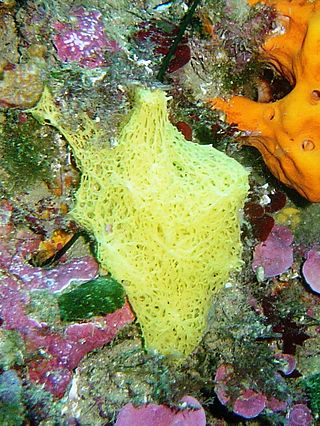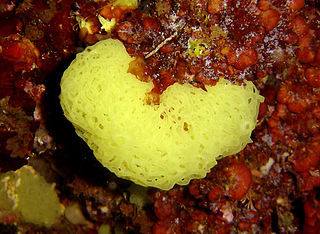
Clathrinidae is a family of calcareous sponges in the order Clathrinida. It contains the following genera:

Clathrina is a genus of calcareous sponge in the family Clathrinidae. Several species formerly in Clathrina were transferred to the newly erected genera Arturia, Ernstia, Borojevia, and Brattegardia in 2013. The name is derived from the Latin word "clathratus" meaning "latticed".
Clathrina aurea is a species of calcareous sponge from Brazil. Specimens of this species were previously misidentified with Clathrina clathrus
Clathrina chrysea is a species of calcareous sponge from New Caledonia. The species epithet refers to the light yellow colour of the sponge.
Clathrina clara is a species of calcareous sponge from India. The name refers to the clear, bright surface of the sponge.
Clathrina conifera is a species of calcareous sponge from Brazil. The species name refers to the cone-shaped appearance of the triactines.

Clathrina coriacea is a species of calcareous sponge belonging to the class Calcarea and family Clathrinidae. Species in the genus Clathrina are composed of calcium carbonate tube-like skeletons containing spicules. The sponge can be located in shallow waters widely distributed along North Atlantic coasts, as well as on other coasts.
Clathrina cribrata is a species of calcareous sponge in the family Clathrinidae. The holotype was collected from Kristiansund, Norway.
Clathrina hondurensis is a species of calcareous sponge from Belize. The species is named for British Honduras, the former name of Belize, at the time the holotype was collected in 1935.
Clathrina laminoclathrata is a species of calcareous sponge from Australia. The species name is in reference to its unusual lamina.
Clathrina multiformis is a species of calcareous sponge from Russia.
Clathrina primordialis is a species of calcareous sponge from Croatia.
Clathrina rotunda is a species of calcareous sponge from South Africa.

Arturia is a genus of calcareous sponge in the family Clathrinidae which contains 14 species. It is named after Arthur Dendy, a prominent researcher of calcareous sponges. It was renamed Arturia in 2017 because the name Arthuria was already assigned to a genus of molluscs.
Clathrina arnesenae is a species of calcareous sponge from the Atlantic Ocean. It is named after Norwegian spongiologist Emily Arnesen (1867–1928).
Clathrina camura is a species of calcareous sponge from the Atlantic Ocean.
Clathrina macleayi is a species of calcareous sponge from Australia.
Clathrina pedunculata is a species of calcareous sponges from Australia.
Clathrina philippina is a species of calcareous sponges from the Philippines.



